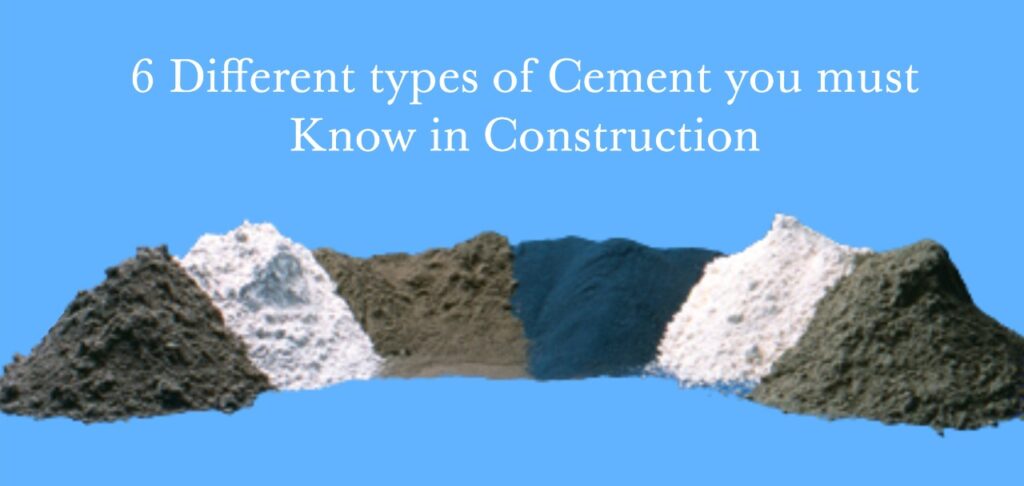6 different types of cement you must know in construction

Cement may be a binding material that creates a bond between aggregates and reinforcing materials together. With the event of technology, quality and kinds of cement have also developed. So there are differing types of cement for various Construction works.
In addition to ordinary hydraulic cement, there are many sorts of cement. Important varieties are briefly explained below:
1. Colored Cement:
The cement of desired colors is produced by intimately mixing pigments with ordinary cement. The chromium oxide gives green color. Cobalt produces a blue color. Iron oxide with different proportions produces a brown, red, or yellow color. The addition of manganese dioxide gives black or brown colored cement. These sorts of cement are used for giving finishing touches to floors, walls, window sills, roofs, etc.
2. Low Heat Cement:
It is a spatial sort of cement that produces low heat of hydration during the setting. Some chemical composition of Ordinary hydraulic cement is modified to scale back the warmth of hydration. The chemical composition of low heat cement may be a low percentage (5%) of tricalcium aluminate (C3A) and a better percentage (46%) of declaiming silicate (C2S).
3. White Cement:
The cement when made free from coloring oxides of iron, manganese, and chromium leads to white cement. Within the manufacture of this cement, oil fuel is employed rather than coal for burning. White cement is employed for floor finishes, plastering, ornamental works, etc. In swimming pools white cement is employed to exchange glazed tiles. It’s used for fixing marbles and glazed tiles.
4. Quick Setting Cement:
Quick setting cement is produced by reducing the share of gypsum and adding a little amount of aluminum sulfate during the manufacture of cement. Finer grinding also adds to the fast setting property. This cement starts setting within 5 minutes after adding water and becomes hard mass within half-hour. This cement is employed to get concrete under static or slowly running water.
5. Rapid Hardening Cement:
This cement are often produced by increasing lime content and burning at high temperatures while manufacturing cement. Grinding to very fine is additionally necessary. Though the initial and final setting time of this cement is that the same as that of hydraulic cement, it gains strength within the youth. This property helps within the earlier removal of formworks and speed in construction activity.
6. Low Heat Cement:
In mass concrete works just like the construction of dams, the warmth produced thanks to the hydration of cement won’t get dispersed easily. This might produce to cracks. Hence in such constructions, it’s preferable to use low heat cement. This cement contains a coffee percentage (5%) of tricalcium aluminate (C3A) and a better percentage (46%) of dicalcium silicate (C2S).
Want to know more about the cements or construction? Don’t wait for the right time! Any time is the right time for you to connect us. Sewakram Realty will guide you to make the right decision for the real estate investment.
Sewakram Realty based in Hubli is a prominent and key player in Real estate construction and contracting business. We are catering to wide range of construction services from residential buildings, commercial properties, industrial projects such as cold storage construction, warehouse building, and road constructions.
Quick Links
Contact Details
Address
1st floor D.M. Patil Layout Opp Traffic Police Station Kusugal Road, Keshwapur, Hubballi-580023
Phone
+91 836-2282111 / +91 84318 95637
realtyofficial@sewakram.com
